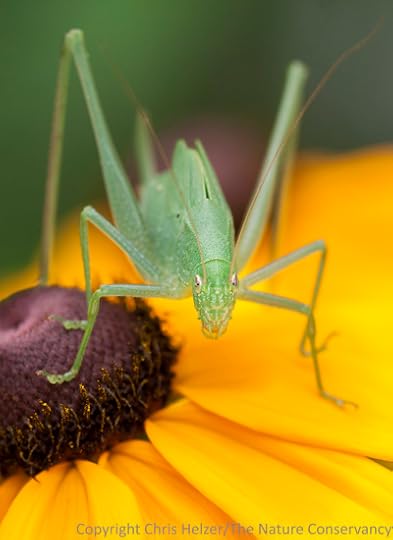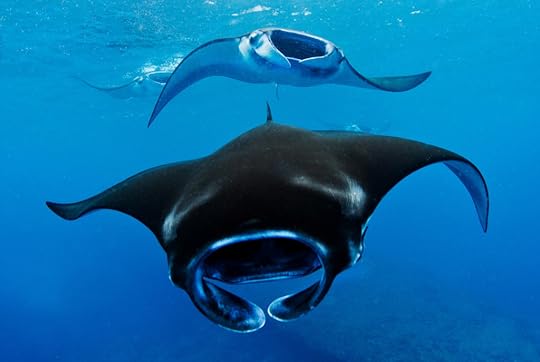Richard Conniff's Blog, page 40
October 7, 2014
Never Mind Biodiversity. Think Color, Movement, Noise
This is a nice description by Chris Helzer, a Nebraska ecologist, about the aftermath of a tour he was giving of some of the prairie habitat he manages for the Nature Conservancy:
As we were finishing the last tour of our site and walking back to the vehicles, Wayne Copp, of the Tall Grass Bison Ranch in Auburn, Kansas, caught up with me. He told me how much he had enjoyed the tours and that he thought our prairies looked great. I thanked him, of course – it’s always nice to hear that. But then he went on…
“A lot of prairies I visit,” he said, “look pretty dead – there’s not much going on. But your prairies are really alive, and they’ve got the three things I always look for in grasslands.”
“Which are?” I asked.
“Color, movement and noise.”
And there you go. I’ve not heard a more concise, all-encompassing description of a good prairie. Even better, you don’t have to be a botanist or ecologist to recognize color, movement and noise. Anyone, regardless of age or background, can walk through a prairie and judge whether or not that prairie has those qualities.
Of course, some of you are already asking, “How MUCH color, movement and noise should there be?”
But Wayne’s criteria for judging prairies (at least as I understand them) are not meant to be quantitative. Sure, more is better, but that’s not really the point. I think he’s just saying
that a prairie without color, movement and noise is deficient. Clean and simple.
Sure, we still need other indicators and measures that can help us identify trends in plant diversity or species’ population viability. We still need to figure out what to look for as we evaluate past management actions and plan the next ones. And we still need to better understand what factors can indicate whether a prairie is ecologically resilient.
Unfortunately, only those of us who spend the majority of our time working in prairies can get much good out of those highfalutin indicators, measures, and factors. They are important, but only to a small subset of people. For everyone else – and us prairie wonks too – Wayne has already figured out the three essential qualities every prairie should have.
Color, movement and noise.
Brilliant.


October 2, 2014
How Monarch Butterflies Found (and Lost) Their Migration

Monarchs at their overwintering site cluster against the cold (Photo: Jaap de Roodee)
As the monarch butterfly migration faces a worsening risk of extinction, a research team has discovered the basis of that legendary migration in a single gene. Genetic analysis also suggests that monarch butterflies originated here in North America, not in the tropics, as previously thought.
Here’s the press release:
The monarch butterfly is one of the most iconic insects in the world, best known for its distinct orange and black wings and a spectacular annual mass migration across North America. However, little has been known about the genes that underlie these famous traits, even as the insect’s storied migration appears to be in peril.
Sequencing the genomes of monarch butterflies from around the world, a team of scientists has now made surprising new insights into the monarch’s genetics. They identified a single gene that appears central to migration — a behavior generally regarded as complex — and another that controls pigmentation. The researchers also shed light on the evolutionary origins of the monarch. They report their findings Oct. 1 in Nature.
“The results of this study shift our whole thinking about
these butterflies,” said study senior author Marcus Kronforst, PhD, Neubauer, an ecologist at the University of Chicago.
Every year, millions of monarchs fly from as far north as Canada to spend the winter in Mexico. Predominantly a North American species, the monarch also exists in South and Central America, and has relatively recently spread across the Atlantic and Pacific oceans. Only North American monarchs migrate.
A North American Original
To better understand monarch genetics and the basis for migratory behavior, Kronforst’s team sequenced and compared the genomes of 101 butterflies, including migratory North American monarchs, non-migratory monarchs from around the world and a few closely related species.
The researchers analyzed the monarch’s evolutionary origins using genetic comparisons. They traced the ancestral lineage of monarchs to a migratory population that likely originated in the southern U.S. or Mexico. The monarch’s current worldwide distribution appears to stem from three separate dispersal events — to Central and South America; across the Atlantic; and across the Pacific. In all three cases, the butterfly independently lost its migratory behavior.
The monarch’s North American origin runs counter to a long-standing hypothesis that the butterfly originated from a non-migratory tropical species, which later developed the ability to migrate. While historical records have suggested that the monarch’s dispersal across the Pacific and Atlantic occurred in the 1800s, the analysis indicated the monarch actually crossed the oceans thousands of years ago. The authors note that more work needs to be done to fully document the butterfly’s evolutionary history.
“In order to clearly resolve the history of monarch butterflies, we still need additional fossil, archaeological and genetic data, as well as more advanced technology, becoming available in the future,” said study author Shuai Zhan, PhD, a professor in Shanghai Institutes for Biological Sciences and a former joint postdoctoral fellow at the University of Chicago and the University of Massachusetts Medical School.
Slow and Steady
To study the genetic basis for migration, the team compared the genomes of migratory butterflies against the three non-migratory populations. They identified more than 500 genes — most of which are involved in muscle, developmental and neural function — that differed to some degree. But a single gene disparity stood out.
Migratory butterflies expressed greatly reduced levels of collagen IV α-1, a gene involved in flight muscle formation and function. The team discovered that migratory monarchs consumed less oxygen and had significantly lowered flight metabolic rates, which likely increases their ability to fly long distances compared to non-migratory butterflies.
“Migration is regarded as a complex behavior, but every time that the butterflies have lost migration, they change in exactly the same way, in this one gene involved in flight muscle efficiency,” said Kronforst. “In populations that have lost migration, efficiency goes down, suggesting there is a benefit to flying fast and hard when they don’t need to migrate.”
The Color Gene
The researchers also investigated the genetic basis for the monarch’s famous coloration. A small percentage of monarchs, most notably in Hawaii, possess white and black wings instead of orange. Comparing the genomes of these butterflies against normally colored populations, the team discovered a single gene appears to function as a pigmentation switch.
This gene, which codes for a protein of the myosin motor protein family, has never before been implicated in insect coloration. Its mutation likely disrupts the pigment transport to the wings, making the monarchs white. A related gene in mice, myosin 5a, has been shown to affect coat color in a similar way. The gene represents a new genetic pathway to explore insect coloration, according to Kronforst.
Migration in Peril
Although the monarch isn’t in danger of extinction, its famous mass migration across North America appears to be in peril. In 1996, around one billion monarchs migrated to Mexico for the winter. Estimates for the past year place the number at around 35 million. A likely culprit is the loss of milkweed, the monarch’s primary habitat, due to agricultural herbicide use. Meanwhile, monarchs that used to migrate are transitioning into non-migratory populations around the Gulf Coast.
The results of this study emphasize the need for conservation efforts to preserve the iconic migration and extend the extraordinary evolutionary history of the monarch butterfly, according to the authors.
“You used to see huge numbers of monarchs, clouds of them passing by,” said Kronforst. “Now it looks quite possible that in the not too distant future, this annual migration won’t happen.”


October 1, 2014
Wild Horses a Problem for Ranchers? Wolves Could Fix That
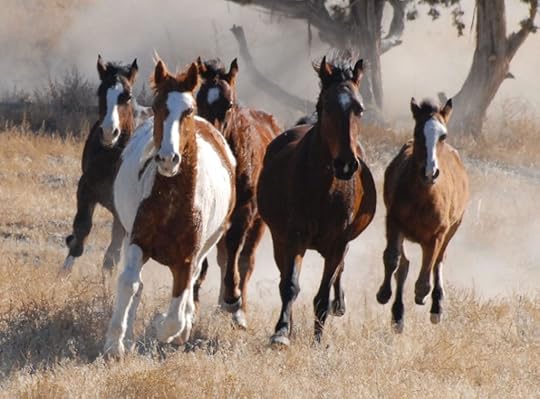 Today’s New York Times has a report on the wild horse population boom in the American West, and for once, I agree with the ranchers: Bizarre federal policies over the last 40 years have caused wild horses to run out of control, causing rampant overgrazing while also running up out-of-control costs (currently $50 million a year) to house horses that have been taken off the land, but can’t be euthanized.
Today’s New York Times has a report on the wild horse population boom in the American West, and for once, I agree with the ranchers: Bizarre federal policies over the last 40 years have caused wild horses to run out of control, causing rampant overgrazing while also running up out-of-control costs (currently $50 million a year) to house horses that have been taken off the land, but can’t be euthanized.
The federal policies are the result of misguided sentimental attitudes about a favored species, the same sort of attitudes that cause city people to feed feral cats in parks that would otherwise be havens for wildlife. If animal rights activists want to protect excess horses from being euthanized, or sold for meat, they should be picking up that $50 million cost of housing them, not taxpayers.
And here’s an idea for the ranchers: If you want to keep down the horse population, learn to tolerate wolves, grizzly bears, and other predators. They would act as a natural check on the horses. And, yes, you can have wolves and cattle, too, just get back to traditional ranching methods of protecting your herds.
If you’re not willing to do that on federal lands, nobody’s going to mind too much if the horses drive you out of business.
Here’s an excerpt from The Times:
On his ranch, Mr. Wintch drove up to a juniper-dotted hillside where a few years before, state wildlife workers had fenced in eight-foot squares with wire mesh to study the effect of grazing. In the protection of the squares, tawny tufts of Indian rice grass nodded in the breeze. Outside the squares, hard-packed dirt held a few vestiges of grass cropped down to nubs.
“This is all horses,” he said. “I haven’t put out cattle here at all this year.”
Last fall, the Bureau of Land Management sent a letter to Mr. Wintch and a dozen other ranchers in the region, saying that wild horses were increasing and that with no money for roundups, the ranchers should voluntarily cut their herds by half.
So this spring, Mr. Wintch sold a third of his cattle and let the rest out in his hayfields, where, he said, they will eat about $150,000 in winter hay.
“We can’t last out here if this continues,” Mr. Wintch said.
The Bureau of Land Management replied to the lawsuit by Mr. Wintch and the group of other local ranchers last week, denying it has violated federal law by failing to control horse populations.
“We don’t want to sue, but this is killing us financially,” said Tammy Pearson, who ranches near Mr. Wintch.
This summer, she kept her cattle out of the Bureau of Land Management pasture she leases because, she said, the horses had eaten the grass.
“It’s not a horse issue,” she said, looking across the pasture, where about 60 wild horses grazed. “It’s a range health issue. This land is getting beat up pretty good. Sure, it’s easy to blame the ranchers, but if you took us all off the land, you still wouldn’t solve the problem. The horses would just continue to expand. And then what?”


September 30, 2014
The Half-Life of Wildlife
I don’t know about you, but I can remember 1970. I was a freshman in college then, and the idea that half of the Earth’s wildlife has disappeared in my adult lifetime fills me with shame. It makes me think of Wordsworth*, with a twist: Getting and spending we lay waste their powers.
Here’s the press release on the new report from the World Worldlife Fund:
Between 1970 and 2010 populations of mammals, birds, reptiles, amphibians, and fish around the globe dropped 52 percent, says the 2014 Living Planet Report released today by World Wildlife Fund (WWF). This biodiversity loss occurs disproportionately in low-income countries—and correlates with the increasing resource use of high-income countries.
In addition to the precipitous decline in wildlife populations the report’s data point to other warning signs about the overall health of the planet. The amount of carbon in our atmosphere has risen to levels not seen in more than a million years, triggering climate change that is already destabilizing ecosystems. High concentrations of reactive nitrogen are degrading lands, rivers and oceans. Stress on already scarce water supplies is increasing. And more than 60 percent of the essential “services” provided by nature, from our forests to our seas, are in decline.
“We’re gradually destroying our planet’s ability
to support our way of life,” said Carter Roberts, president and CEO of WWF. “But we already have the knowledge and tools to avoid the worst predictions. We all live on a finite planet and its time we started acting within those limits.”
The Living Planet Report, WWF’s biennial flagship publication, measures trends in three major areas:
• populations of more than ten thousand vertebrate species;
• human ecological footprint, a measure of consumption of goods, greenhouse gas emissions; and
• existing biocapacity, the amount of natural resources for producing food, freshwater, and sequestering carbon.
“There is a lot of data in this report and it can seem very overwhelming and complex,” said Jon Hoekstra, chief scientist at WWF. “What’s not complicated are the clear trends we’re seeing — 39 percent of terrestrial wildlife gone, 39 percent of marine wildlife gone, 76 percent of freshwater wildlife gone – all in the past 40 years.”
The report says that the majority of high-income countries are increasingly consuming more per person than the planet can accommodate; maintaining per capita ecological footprints greater than the amount of biocapacity available per person. People in middle- and low-income countries have seen little increase in their per capita footprints over the same time period.
While high-income countries show a 10 percent increase in biodiversity, the rest of the world is seeing dramatic declines. Middle-income countries show 18 percent declines, and low-income countries show 58 percent declines. Latin America shows the biggest decline in biodiversity, with species populations falling by 83 percent.
“High-income countries use five times the ecological resources of low-income countries, but low income countries are suffering the greatest ecosystem losses,” said Keya Chatterjee, WWF’s senior director of footprint. “In effect, wealthy nations are outsourcing resource depletion.”
The report underscores that the declining trends are not inevitable. To achieve globally sustainable development, each country’s per capita ecological footprint must be less than the per capita biocapacity available on the planet, while maintaining a decent standard of living.
At the conclusion of the report, WWF recommends the following actions:
1. Accelerate shift to smarter food and energy production
2. Reduce ecological footprint through responsible consumption at the personal, corporate and government levels
3. Value natural capital as a cornerstone of policy and development decisions
* Here’s the Wordsworth poem, which all this brings to mind:
The world is too much with us; late and soon,
Getting and spending, we lay waste our powers;—
Little we see in Nature that is ours;
We have given our hearts away, a sordid boon!
This Sea that bares her bosom to the moon;
The winds that will be howling at all hours,
And are up-gathered now like sleeping flowers;
For this, for everything, we are out of tune;
It moves us not. Great God! I’d rather be
A Pagan suckled in a creed outworn;
So might I, standing on this pleasant lea,
Have glimpses that would make me less forlorn;
Have sight of Proteus rising from the sea;
Or hear old Triton blow his wreathèd horn.


Want to Save Salt Marshes? Send in the Goats
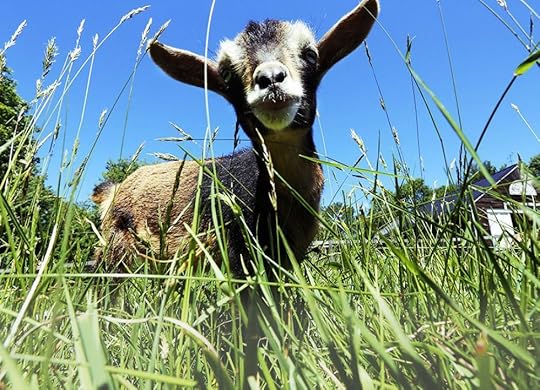
(Photo: Derek Davis/Getty Images)
As I write this, I am sitting on my porch in Connecticut looking out at a coastal salt marsh, a habitat that seems to be increasingly under threat everywhere, in part because of a tall grass called Phragmites australis. When I first moved here, the marsh was a wall of phragmites, in a dense stand 10-feet high, from one side to the other. Hardly any wildlife seemed to live there, except redwing blackbirds. The roots, or rhizomes, of the phragmites grew one on top of the other, crowding out native plants and threatening to turn the marsh into dry land.
When a study demonstrated that out-of-control phragmites are an invasive variety introduced in the nineteenth century from Europe, I went to work, deploying a one-man version of the anti-phragmites protocol now used by many state environmental protection agencies. Wearing a backpack sprayer, I cut tunnels through the dense foliage, then worked my way back out, spraying an herbicide called Rodeo, an aquatic variety of Roundup, on the leaves of the phragmites. I wasn’t comfortable with the idea (and in neighboring New York the practice is illegal). But it seemed to work. The phragmites started to die back, and I saw a lot more wildlife, from otters to glossy ibis.
Now, though, a new study proposes a better way get the same results with less work, lower cost, and fewer environmental complications:
Send in the goats.
Duke University ecologist Brian Silliman got the idea while doing research on marshes in Europe. He noticed that the same variety of phragmites turned up there mainly in drainage ditches and at construction sites. But the marshes remained
open. Livestock commonly graze in the marshes, a practice that would horrify most American conservationists. But Silliman wondered if the livestock was keeping the phragmites in check.
It turned out that horses, cows, and goats all readily eat phragmites, and when Silliman got back to North Carolina, he discovered that Andrew H. Baldwin at the University of Maryland had already begun a series of experiments. The researchers set up 40-meter-long fenced enclosures in a Maryland marsh that looked the way mine used to look: wall-to-wall phragmites. Then they added in two goats, on the theory that one would be lonely, and three would eat too much too fast.
After a few weeks, the goats had nibbled the phragmites down to stubble, and the researchers moved them on to the next enclosure. When the phragmites re-sprouted, the goats came back for a second round. The idea, said Silliman, was to burn up all the energy reserves stored away in the dense tangle of roots. By the end of the experiment, the goats had reduced the phragmites cover from 94 percent of the test area to just 21 percent. Native plants increased proportionately.
But is the idea practical on the kind of large scale needed to save coastal marshes? The researchers point out that land managers “have treated over 80,000 hectares of marsh with herbicide over the past five years with limited success, despite costs that exceed $4.6 million per year.” Mechanical techniques, including digging up or mowing the phragmites are even more costly, and also ineffective.
The goat idea isn’t an entirely risk-free alternative. The new study warns that use of goats would have to be timed to take account of nesting birds and other environmental considerations. It would also require setting up temporary enclosures with electric fencing, said Silliman, to keep the goats from devouring native species. But he argued that it would be a lot cheaper to pay farmers a fee to graze their goats in the phragmites than to pay contractors for spraying herbicides.I told Silliman I didn’t think state environmental agencies would go for it. But he pointed out that a town in North Carolina is already using goats to control kudzu, and the New York State Department of Environmental Conservation is testing goats for control of invasive species on Long Island.
Will others follow? Stay tuned. With luck, we may yet see our coastal salt marshes re-opened and celebrate with a feast of very locally grown Jamaican curried goat.


Indonesia Busts Manta Ray Poachers
Following on the good news of multiple arrests of elephant poachers in Mozambique, Indonesia is now cracking down on people who traffick illegally in manta ray parts. It’s very encouraging to see this kind of enforcement from developing nations that have experienced some of the most dramatic wildlife losses ever.
Here’s the press release from the Wildlife Conservation Society:
NEW YORK (SEPTEMBER 30, 2014) – The Ministry of Marine Affairs and Fisheries (MMAF), Government of Indonesia, and the Wildlife Conservation Society (WCS)’s Wildlife Crimes Unit announced today the first-ever series of enforcement actions against a trader of sharks and rays in Indonesia, home to the largest shark fisheries on earth.
Between August 22nd and September 26th, 2014, the team of officials, led by Pantja Waluyo Prasetyanto of the Ministry of Marine Affairs and Fisheries, arrested four traders of CITES-listed sharks and rays products, assisted by the WCS Wildlife Crimes Unit.
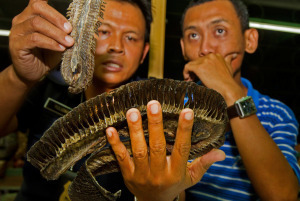
A fisheries police dicusses the difference between manta and mobula ray gills (Photo: Paul Hilton/WCS)
The first arrest took place on August 22nd in Surabaya, Indonesia, the nation’s second largest city, and involved a shipment of 50kg (110 pounds) of gill plates, of which 19.5kg (43 pounds) were from manta rays – two newly protected species under Indonesian law; and 13kgs (28 pounds) of marine turtle meat. The arrested trader, named Suep, is the owner of Sido Mampir Seafood.
Then on September 1st, in Bali, the Indonesian National Police’s Criminal Investigation Division, led by Police Adjunct Senior Commissioner Sugeng Irianto, arrested a trader Johan who was trafficking 53 snouts of the Critically Endangered sawfish ray.
The third arrest by the MMAF team, of a trader named Jnd, took place on September 9th in Sidoarjo near Surabaya. The team confiscated 558 kg (1,231 pounds) of manta ray bones, 4 kg (8.8 pounds) of sea turtle scales, manta gill plates and nautilus shells.
A final arrest occurred on September 26th at the Indramayu fisheries landing site in West Java, when a fisheries trader named Wrm was apprehended by MMAF trying to sell an entire
manta ray weighing 60kg (132 pounds). Under Indonesian law, trafficking manta rays and their parts and products is punishable by a maximum fine of USD $25,000; while for sawfish, sea turtles and nautilus, the penalty is a maximum 5 years’ imprisonment and maximum fine of USD $10,000.
Reef (Manta alfredi) and oceanic (Manta birostris) manta rays are large, long-lived, plankton-eating cartilaginous fishes, relatives of sharks. Oceanic mantas can reach up to 7 meters (23 feet) in length from wing-tip to wing-tip, weigh over 2 tons, and live for at least 20 years. They have very low reproductive rates, giving birth to only one live pup every two years. A growing tourism trade based upon manta-watching is estimated to be worth $140 million annually, with Indonesia as one of the top-ten destinations.
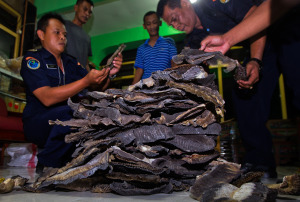
Fisheries police sort manta ray gills during the arrest.
Manta rays are increasingly targeted for their gill plates, the pre-branchial appendages that filter the plankton on which they feed. These gill plates are in demand in Chinese markets for use in a health tonic that is not recognized in traditional Chinese medicine (TCM). One kilo of manta gill plates can fetch $250-$500 in China, and the total trade is worth $30 million annually. This growing trade is driving dramatic increases in largely unregulated manta fisheries that have depleted or are depleting manta populations. Both species are listed as Vulnerable on the IUCN
Red List of Threatened Species, the global threatened species list.
In February 2014, the Ministry of Marine Affairs and Fisheries (MMAF), with technical input from a coalition of conservation organizations, including Conservation International (CI), the Manta Trust, and WCS, banned the hunting and trade of manta rays throughout the total area of the country (6 million square kilometers or 2.3 million square miles). This arrest is the first law enforcement actions under the new manta protection regulation.
“Illegal trading of protected species threatens the sustainability of marine and fisheries resources in Indonesia,” said the Minister of Marine Affairs and Fisheries, Sharif C. Sutardjo, who congratulated the team. “We have succeeded to thwart the illegal trade of manta gill plates, which is was recently listed as a protected species by the Government of Indonesia” said Asep Burhanudin, the Director General of Marine and Fisheries Resources Surveillance of MMAF.
Manta and mobula rays lined up at the Tanjung Luar fish market, Lombok.
“This arrest is a major first step in new enforcement efforts to protect sharks and rays in Indonesia, which operates the largest known shark and ray fisheries on earth,” said Joe Walston, WCS Vice President for Field Conservation. “This arrest sends a clear message that Indonesia is serious about protecting its natural heritage against illegal wildlife traders.”
WCS’s Wildlife Crimes Unit (WCU) operates in Indonesia to provide data and technical advice to law enforcement agencies to support the investigation and prosecution of wildlife crimes. The WCU’s most recent success was assisting the Government of Indonesia’s smashing of a tiger poaching ring earlier this year. Information relating to the trade of manta rays in Indonesia was provided to the WCU by the Jakarta Animal Aid Network (JAAN).
WCS’s Wildlife Crimes Unit is supported by the Save Our Species Fund. Save Our Species is a joint initiative of the Global Environment Facility, IUCN and the World Bank. A fundamental goal is to ensure the long-term survival and well being of threatened species and their critical habitats for biodiversity conservation. WCS’s marine conservation work in Indonesia has been made possible through the generous support of the John D. and Catherine T. MacArthur Foundation and the David and Lucile Packard Foundation. In addition, Conservation International provided financial support to WCS for this manta enforcement work, and the John D. and Catherine T. MacArthur Foundation and the David and Lucile Packard Foundation have also funded Conservation International’s policy work in Indonesia on sharks and rays.
WCS has prioritized saving sharks and rays as part of a global commitment to promote the recovery of depleted and threatened populations of marine species, halt the decline of fragile marine ecosystems, and improve the livelihoods and resilience of coastal communities throughout the world’s oceans.
WCS invests in a diverse array of long-term, seascape-scale conservation strategies across the waters of 20 countries and all five oceans to reverse the decline of marine ecosystems, restore populations of threatened marine species and improve coastal fisheries and livelihoods.
WCS inspires millions to take action for the oceans through the New York Aquarium and all WCS parks in New York City. To achieve long-term conservation goals, WCS marine conservationists work with local and national governments, as well as a range of local partners to improve management of coastal fisheries, mitigate key threats to marine species, expand effective marine protected areas, enhance ocean industry sustainability, and increase resilience to climate change. Collectively, these efforts aim to build broader and deeper public understanding, advance scientific knowledge, and strengthen political commitment to our oceans and the biodiversity and livelihoods they support.


September 28, 2014
Ireland’s Shawshank Hero: Tunnels to Pub to Escape Snoring Wife
I can’t think of any plausible reason to run this piece. Shocking news that movies produce unpredictable effects in human behavior? Um, no. But I love the Irish in all their perversity and, wait, their penchant for strange behaviors.
Beware that the source may not be 100 (or even 30) percent reliable (“Gombeen” is an Irish term for a small-scale wheeler-dealer thief).
Any way, read it for a laugh (especially the last line):
Omagh’s ‘Shawshank Husband’
Dug Tunnel From Bedroom To Pub
Over 15 Years; Wife Snored Too Loud
Kerry re-enacts escape from wife’s snoring.
An Omagh plumber tunnelled a hole from under his bed to the local pub 800 feet from his house over the course of 15 years, a court heard today.
Patsy Kerr had been summonsed to Omagh County Court after it emerged he had been the cause of a collapsed sewage pipe from a neighbouring house. Kerr told the court about his secret tunnel and the reasons behind it:
“The wife has a bad snore on her and after watching the Shawshank Redemption on RTE one night in 1994, I decided to do something about it so I waited til she was in a deep sleep and then set about digging a hole under the bed in the direction of the pub. I used all manner of tools from spoons to a heavy duty tunnel boring machine I managed to sneak down there when she was at the shops. It wasn’t until 2009 that I hit the jackpot and came up through the women’s toilet mop and bucket room.”
Kerr explained how he spent the last five years heading to the pub via his tunnel at 11pm before returning at 1am, undetected by his deep sleeping wife:
“To be honest I was sort of glad I was caught. She was always smelling drink off me in the morning and I was explaining it away as
a natural odour. But recently I was finding myself singing rebel songs and stuff coming back up the tunnel and it was only a matter of time before I was caught anyhow. The landlord was also wondering how I was just appearing out of nowhere at the same time every night and disappearing from the women’s toilets.”
The tunnel was finally discovered after the DOE performed a survey on a sewage problem which turned out to be caused by a pipe Kerr had hit accidentally, causing sewage to leak into his tunnel over five years. The judge questioned Kerr’s wife as to why she never smelt the sewage odours from her husband. Mrs Kerr simply shrugged.


A U.S. Plan to Sacrifice Wolves for Lumber
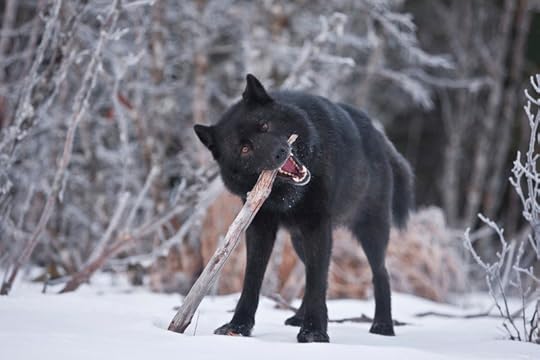
A proposed USFS logging auction threatens this wolf subspecies (Photo: Hyde?)
Today’s New York Times reports on a U.S. Forest Service (USFS) plan to cut most of the remaining virgin forest on Prince of Wales Island Island in the Tongass National Forest on the Alaska coast. Conservationists say the proposed auction, called Big Thorne, threatens a wolf population that’s already in trouble:
In the island’s northern half, nearly 94 percent of the biggest stands of virgin forest have been cut down. Big Thorne will clean up some of what remains; the 9.7 square miles of woodlands marked for cutting are sprinkled over 360 square miles, much of it clear-cut in decades past.
The conservationists’ lawsuit argues that the Forest Service ignored the law and its own rules in choosing tracts of forest for logging in Big Thorne and five other sites. Example 1, they say, is the Alexander Archipelago wolf. [N.B., my link. The NY Times linked to the USFS site for the subspecies.]
The wolf, a smaller, many-colored cousin of the timber wolf, relies on the Sitka black-tailed deer for food. The deer winter in the island’s old-growth forests, where big trees and underbrush provide forage, shelter from snows and cover from the island’s hunters.
Federal rules require the Forest Service “to maintain viable populations” of the wildlife on its lands. For the wolf, that means having enough deer
for itself and deer hunters, too — 18 per square mile, the Forest Service said in 2008. But at the same time, the lawsuit argues, the agency downgraded that 18-deer requirement to a guideline, one the suit claims it disregarded in Big Thorne and elsewhere by proposing to auction off prime deer habitat.
The lawsuit seeks only to enforce the deer habitat requirement on Forest Service lands. But it could tie up at least some auctions in court — and, should conservationists win, even send Big Thorne back to the drawing board.
Read the full article here.


September 27, 2014
Kingfisher Triumphant
This photo is from the Epson International Pano Awards, a photo contest, and a selection of winners is appearing in the Mail Online. I think a number of the winners could have competed in the Best Photoshopping category, or maybe The Best Manipulation of a Photograph Beyond Any Resemblance to Reality.
But I like kingfishers, and this photo by Haibo Chi seems like the real deal.


September 26, 2014
How A Fur Coat Is Helping Save an Endangered Cat
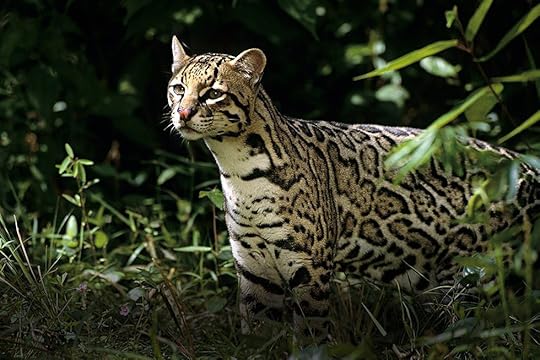 My latest for Takepart.
My latest for Takepart.
Everybody has some dreadful bit of family history stashed away in the attic and preferably forgotten. For the Rockefeller heirs last week, it was their investment in the fossil fuel industry, largely founded by their oil baron ancestor John D. Rockefeller. For me, it was an ocelot jacket inherited from my wife’s grandmother.
And let me tell you, it is hard to write about endangered species when you have a dead one literally hanging over your head. Or more like 15 dead ocelots, to make up the single carcoat-length jacket that has been hidden away in my attic for several decades now. So I decided to get rid of it, more or less the way the Rockefellers decided last week to divest their millions from fossil fuel companies. Only on a somewhat more modest scale.
Ocelots are beautiful little cats, roughly twice the size of a house cat and covered in elongated spots that seem to want to become stripes. They’re hide-and-pounce predators, and tend to be solitary and elusive, but still range through much of South and Central America, and up both coasts of Mexico. The fur trade used to kill as many as 200,000 ocelots annually for jackets like the one in my attic, which probably dates from the 1950s. But that traded ended in the 1980s, under the Convention on International Trade in Endangered Species (CITES).
Even so, ocelots continues to decline across most of their home range, largely because of habitat loss, roadkill incidents, and inbreeding in populations that have become isolated. Two such populations, totaling fewer than 100 animals, survive in and around the Laguna Atascosa National Wildlife Refuge in Brownsville, Texas, in the Rio Grande valley, and ocelots also sometimes turn up in southern Arizona. So I phoned up the U.S. Fish and Wildlife Service (FWS) at Laguna Atascosa and asked them what to do when in possession of an endangered species, other than proceed directly to jail. Happily, they wanted the jacket as an educational tool.
“You want me to give my grandmother’s jacket to someone from Texas?” my wife cried, full of New England umbrage, when I broached the idea.

Each dark line represents a dead ocelot (Photo: Richard Conniff)
“I sent them a photo. They say that jacket has 15 ocelots in it. Maybe more.”
“I didn’t do it.”
” You’re not going to wear it, and you can’t sell it. What are you going to do with it?”
She retreated to the bathroom, where we have a lot of family pictures, saying, “I’m going to have to talk to my grandmother.” After a minute, from behind the closed door, she added, “Did you tell them I don’t trust Texans?
“They’ll put it on display in the visitor center.”
“That has to be in the contract,” she said.
I phoned Laguna back, and this time chatted with an ocelot biologist named Hilary Swarts, who by good fortune grew up in Connecticut, where we live. She even went to the same summer camp as our kids. Texas problem solved. My wife packed the jacket and mailed it herself.
Swarts told me about work to increase the ocelot population at Laguna Atascosa, including a plan being negotiated to boost genetic diversity by bringing in a female ocelot from a Mexican population. Research a few years ago also demonstrated that up to 40 percent of ocelot deaths at Laguna result from collisions with vehicles. The refuge is currently working with the Texas Department of Transportation on a plan to install eight wildlife crossings on a busy road that runs through the refuge.
But according to Tom DeMaar, a veterinarian who heads the Friends of Laguna Atascosa, the refuge is also in the middle of intense negotiations with TexDot, as it’s known, about addressing a deadly problem on another road. State Highway 100 is a busy four-lane road running alongside the refuge on a route that leads to South Padre Island, a popular spring break destination. A few years ago, to reduce drunk driving and other accidents, TexDot installed a concrete center barrier, ignoring the recommendation from biologists that it use guardrails instead to allow wildlife to cross under. Since then, three ocelots have been trapped on the road and killed by vehicles, the most recent of them this July.
According to DeMaar, a spokeman for TexDot in one interview described the ocelot as “a Texas National Treasure,” but also said replacing the concrete barriers would cost $1 million–too much money. “If a ‘Texas national treasure’ is not worth $1 million,” DeMaar asked, “What is it worth?” In a negotiation, he added, a TexDot employee wondered if the small size of the ocelot population didn’t mean it was doomed to disappear in any case, “and then the issue would go away?” DeMaar suggested that TexDot might change its attitude under public pressure, best addressed to its executive director, Tom Weber, by phone at (512) 305-9515 or by email.
Meanwhile, my wife’s grandmother’s ocelot jacket is out of the attic and making the rounds at Texas schools and other outreach events. “Although it’s tough to see something that represents a different time in our treatment of wild animals,” Hilary Swarts told me, “it’s a really powerful tool in showing the public how many cats it takes to make a jacket and how much more beautiful they are on actual, live ocelots. It’s one thing to tell them about it, but it’s always more powerful when you can show them.”
If it gets people angry enough to support the Laguna Atascosa ocelots—and fix that highway–I think even my wife’s grandmother might consider that a happy ending.






